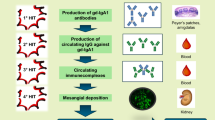Abstract
To retrospectively analyze the efficacy and safety of febuxostat on gout patients with low serum uric acid level. A study was conducted in Nanjing First Hospital from October 2015 to September 2016. Thirty nine acute gouty arthritis patients from the emergency and outpatient department were included. Patients met the 2015 Gout Classification Criteria revised by American College of Rheumatology/European League Against Rheumatism (ACR/EULAR) and had urate deposition around the joints detected by dual-energy computerized tomography (DECT). Patients whose serum uric acid (SUA) were between 5.0 and 7.0 mg/dl (300–420 μmol/l) received febuxostat treatment to maintain the SUA level between 3.0 and 5.0 mg/dl for 1 year. Efficacy and safety of febuxostat were observed during the process. Three of 39 subjects were excluded because of adverse events (AEs) after receiving an initial febuxostat treatment for 2 months. Thirty six subjects were enrolled. The mean SUA level was reduced significantly from 6.51 ± 0.28 mg/dl at baseline to 4.24 ± 0.38 mg/dl and SUA of all subjects decreased by 34.8% compared with baseline. After 1-year treatment, the volume of tophus was reduced approximately 62.8%. Serum creatinine decreased stepwise in 8 gout patients with chronic kidney diseases from 162.5 ± 9.2 μmol/l to 131.4 ± 11.0 μmol/l. Two months after initiation of treatment, the number of gout flares began to markedly decrease and almost did not occur after 1 year. After the 1-year treatment of febuxostat, the average SUA level declined significantly, and the renal function improved gradually. There was nearly complete abolition of gout flares by the end of the study. Tophi resolved markedly compared with baseline as assessed by DECT. Furthermore, only a few people experienced adverse events. Febuxostat has a notable effect for gout patients in the lower SUA level range.





Similar content being viewed by others
References
Karis E, Crittenden DB, Pillinger MH (2014) Hyperuricemia, gout, and related comorbidities: cause and effect on a two-way street. South Med J 107:235–241
Neogi T, Jansen TLTA, Dalbeth N, Fransen J, Schumacher HR, Berendsen D, Brown M, Choi H, Edwards NL, Janssens HJEM, Lioté F, Naden RP, Nuki G, Ogdie A, Perez-Ruiz F, Saag K, Singh JA, Sundy JS, Tausche AK, Vaquez-Mellado J, Yarows SA, Taylor WJ (2015) 2015 gout classification criteria: an American College of Rheumatology/European League Against Rheumatism collaborative initiative. Arthritis Rheum 67:2557–2568
Richette P, Doherty M, Pascual E et al (2017) 2016 updated EULAR evidence-based recommendations for the management of gout. Ann Rheum Dis 76(1):29–42
Shi D, Xu J-X, Wu H-X, Wang Y, Zhou QJ, Yu RS (2015) Methods of assessment of tophus and bone erosions in gout using dual-energy CT: reproducibility analysis. Clin Rheumatol 34:755–765
lvarez-Lario B, Macarrón-Vicente J (2010) Uric acid and evolution. Rheumatology 49:2010–2015
Squadrito GL, Cueto R, Splenser AE, Valavanidis A, Zhang H, Uppu RM, Pryor WA (2000) Reaction of uric acid with peroxynitrite and implications for the mechanism of neuroprotection by uric acid. Arch Biochem Biophys 376:333–337
Decker J (1966) Report from the subcommittee on diagnostic criteria for gout. In: Population studies of the rheumatic diseases. Proceedings of the Third International Symposium, New York. p 385–387
Wallace SL, Robinson H, Masi AT, Decker JL, Mccarty DJ, Yü T'F (1977) Preliminary criteria for the classification of the acute arthritis of primary gout. Arthritis Rheum 20:895–900
Lawrence J (1964) The epidemiology of chronic rheumatism. Ann Rheum Dis 23:81–82
Janssens HJ, Fransen J, Van De Lisdonk EH et al (2010) A diagnostic rule for acute gouty arthritis in primary care without joint fluid analysis. Arch Intern Med 170:1120–1126
Hu H-J, Liao M-Y, Xu L-Y (2015) Clinical utility of dual-energy CT for gout diagnosis. Clin Imaging 39:880–885
Frampton JE (2015) Febuxostat: a review of its use in the treatment of hyperuricaemia in patients with gout. Drugs 75:427–438
Richette P, Clerson P, Périssin L, Flipo RM, Bardin T (2015) Revisiting comorbidities in gout: a cluster analysis. Ann Rheum Dis 74:142–147
Joo K, Kwon S-R, Lim M-J, Jung KH, Joo H, Park W (2014) Prevention of comorbidity and acute attack of gout by uric acid lowering therapy. J Korean Med Sci 29:657–661
Singh JA (2016) Gout: will the “King of Diseases” be the first rheumatic disease to be cured? BMC Med 14:180
Öztürk MA, Kaya A, Şenel S et al (2013) Demographic and clinical features of gout patients in Turkey: a multicenter study. Rheumatol Int 33:847–852
Spaetgens B, Wijnands JM, Van Durme C et al (2015) Content and construct validity of the rheumatic diseases comorbidity index in patients with gout. Rheumatology 54:1659–1663
Choe JY, Park KY, Kim SK (2015) Oxidative stress by monosodium urate crystals promotes renal cell apoptosis through mitochondrial caspase-dependent pathway in human embryonic kidney 293 cells: mechanism for urate-induced nephropathy. Apoptosis 20:38–49
Mulay SR, Evan A, Anders HJ (2014) Molecular mechanisms of crystal-related kidney inflammation and injury. Implications for cholesterol embolism, crystalline nephropathies and kidney stone disease. Nephrol Dial Transplant 29:507–514
Roughley MJ, Belcher J, Mallen CD, Roddy E (2015) Gout and risk of chronic kidney disease and nephrolithiasis: meta-analysis of observational studies. Arthritis Res Ther 17(1):90
Urano W, Yamanaka H, Tsutani H, Nakajima H, Matsuda Y, Taniguchi A, Hara M, Kamatani N (2002) The inflammatory process in the mechanism of decreased serum uric acid concentrations during acute gouty arthritis. J Rheumatol 29:1950–1953
Dalbeth N, Aati O, Kalluru R, Gamble GD, Horne A, Doyle AJ, McQueen FM (2015) Relationship between structural joint damage and urate deposition in gout: a plain radiography and dual-energy CT study. Ann Rheum Dis 74:1030–1036
Schumacher H Jr, Becker M, Lloyd E et al (2009) Febuxostat in the treatment of gout: 5-yr findings of the FOCUS efficacy and safety study. Rheumatology 48:188–194
Becker MA, Macdonald PA, Hunt BJ et al (2008) Determinants of the clinical outcomes of gout during the first year of urate-lowering therapy. Nucleosides Nucleotides Nucleic Acids 27:585–591
Shibagaki Y, Ohno I, Hosoya T, Kimura K (2014) Safety, efficacy and renal effect of febuxostat in patients with moderate-to-severe kidney dysfunction. Hypertens Res 37:919–925
Becker MA, Schumacher HR, Macdonald PA et al (2009) Clinical efficacy and safety of successful longterm urate lowering with febuxostat or allopurinol in subjects with gout. J Rheumatol 36:1273–1282
Hira D, Chisaki Y, Noda S, Araki H, Uzu T, Maegawa H, Yano Y, Morita SY, Terada T (2015) Population pharmacokinetics and therapeutic efficacy of febuxostat in patients with severe renal impairment. Pharmacology 96:90–98
Ma L, Wei L, Chen H, Zhang Z, Yu Q, Ji Z, Jiang L (2016) Influence of urate-lowering therapies on renal handling of uric acid. Clin Rheumatol 35:133–141
Caspi D, Lubart E, Graff E et al (2000) The effect of mini-dose aspirin on renal function and uric acid handling in elderly patients. Arthritis Rheumatol 43:103–108
Funding
The study received grants from the Key Programs of Medical Science and Technology Development Foundation of the Nanjing Department of Health (No. QRX11026) and the Science and Technology Development Foundation of Nanjing Medical University (No. 2014NJMU047).
Author information
Authors and Affiliations
Corresponding author
Ethics declarations
Disclosures
None.
Rights and permissions
About this article
Cite this article
Shen, M., Zhang, J., Qian, K. et al. Febuxostat in the treatment of gout patients with low serum uric acid level: 1-year finding of efficacy and safety study. Clin Rheumatol 37, 3107–3113 (2018). https://doi.org/10.1007/s10067-018-4283-z
Received:
Revised:
Accepted:
Published:
Issue Date:
DOI: https://doi.org/10.1007/s10067-018-4283-z




